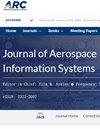多车道无人机交通管理的交叉口规划
IF 1.5
4区 工程技术
Q2 ENGINEERING, AEROSPACE
引用次数: 0
摘要
空域无人机系统(UAS)交通管理是一个需要对无人机(uav)在未知低空G空域中平稳无冲突移动进行战略管理的领域。在先前提出的CORRIDRONE结构的背景下,无人机交通必须组织在连接两个或更多通道的共享空域中,形成多车道走廊网络,从而形成空中交叉路口。本文提出了一种交叉口规划算法,旨在为无人机在交叉口体内提供无冲突路径。路径被建模为转换过程中所涉及的车道的函数,而冲突的解决是通过改变车道来实现的。在冲突路径中找到最优解,使得只有少数路径需要修改,优化变道次数和在交叉口花费的时间。仿真结果包括随机启动时间间隔、不同无人机尺寸、走廊尺寸和不同车道数的交叉走廊,以证明本文所讨论的概念。本文章由计算机程序翻译,如有差异,请以英文原文为准。
Intersection Planning for Multilane Unmanned Aerial Vehicle Traffic Management
Unmanned aerial system (UAS) traffic management of airspace is a domain that demands strategic management of unmanned aerial vehicles (UAVs) for smooth and conflict-free movement in the uncharted low-altitude G airspace. In the context of the previously proposed CORRIDRONE structure, UAV traffic has to be organized in a shared volume of airspace connecting two or more corridors for a network of multilane corridors, resulting in the formation of aerial intersections. In this work, an intersection planning algorithm is proposed that aims to provide no-conflict paths to the UAVs inside the intersection volume. Paths are modeled as a function of the lanes involved in the transition, and conflict resolution is achieved by changing lanes. Optimized solutions are found among the conflicted UAV paths, such that only a few paths need modifying, optimizing the number of lane changes and time spent in the intersection. Simulation results, including random starting time intervals, various UAV sizes, corridor sizes, and differing numbers of lanes in intersecting corridors, are presented to demonstrate the concepts discussed in the paper.
求助全文
通过发布文献求助,成功后即可免费获取论文全文。
去求助
来源期刊

Journal of Aerospace Information Systems
ENGINEERING, AEROSPACE-
CiteScore
3.70
自引率
13.30%
发文量
58
审稿时长
>12 weeks
期刊介绍:
This Journal is devoted to the dissemination of original archival research papers describing new theoretical developments, novel applications, and case studies regarding advances in aerospace computing, information, and networks and communication systems that address aerospace-specific issues. Issues related to signal processing, electromagnetics, antenna theory, and the basic networking hardware transmission technologies of a network are not within the scope of this journal. Topics include aerospace systems and software engineering; verification and validation of embedded systems; the field known as ‘big data,’ data analytics, machine learning, and knowledge management for aerospace systems; human-automation interaction and systems health management for aerospace systems. Applications of autonomous systems, systems engineering principles, and safety and mission assurance are of particular interest. The Journal also features Technical Notes that discuss particular technical innovations or applications in the topics described above. Papers are also sought that rigorously review the results of recent research developments. In addition to original research papers and reviews, the journal publishes articles that review books, conferences, social media, and new educational modes applicable to the scope of the Journal.
 求助内容:
求助内容: 应助结果提醒方式:
应助结果提醒方式:


